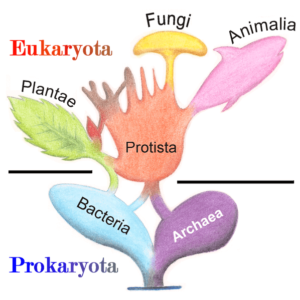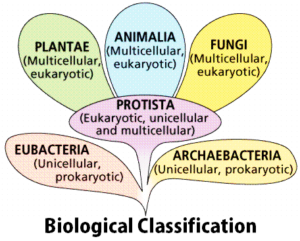Biological classification
Do you understand the meaning of classification or Biological classification ? Classification basically is the arrangement of things in taxonomic groups in accordance with the observed similarities. It helps in understanding the group as a whole with simple ease. Now, here we’ll discuss with you the biological classification and how it has simplified things for us.
What is Biological Classification?
Biological classification is the scientific procedure that involves the arrangement of the organisms in a hierarchical series of groups and sub-groups on the basis of their similarities and dissimilarities.
Since the dawn of civilisation, there have been many attempts to classify living organisms. It was done instinctively not using criteria that were scientific but borne out of a need to use organisms for our own use – for food, shelter and clothing. Aristotle was the earliest to attempt a more scientific basis for classification. He used simple morphological characters to classify plants into trees, shrubs and herbs. He also divided animals into two groups, those which had red blood and those that did not.
Two kingdom classification –
Aristotle – Enaime (have RBC), Anima ((-) RBC)
Linnaeus – Plantae and Animalia
Didn’t separated multicellular- unicellular, eukaryotes- prokaryotes, photosynthetic- non-photosynthetic organisms.
Click Here for Complete Biology Notes
3 Kingdom classification – (Haeckel)
Protista (aquatic unicellular eukaryotes), Animalia, Plantae
4 Kingdom classification – (Copeland)
Monera(prokaryotes), Protista, Animalia, Plantae
5 Kingdom classification- (R.H. Whittaker) [1969]
Monera, Protista, Fungi (Heterotrophs), Animalia, Plantae
6 Kingdom classification – (Carl Woese)
Monera was divided into archaebacteria and eubacteria.
Kingdom Monera
Bacteria are its sole members, survive in harsh conditions.
- Shapes- Coccus – Spherical; Bacillus- rod-shaped; Vibrium- comma-shaped; Spirillum – spiral
- Mode of Nutrition- autotrophic-photosynthetic (utilize sunlight) or chemosynthetic (don’t need sunlight), heterotrophs(common)
- Types- Archaebacteria – most harsh habitat (salty- halophiles, hot spring- thermoacidophiles, marshy- methanogens) due to rigid cell wall.
Methanogens- gut of ruminant animals (cows, buffaloes) responsible for production of methane (biogas) from dung.
- Eubacteria – (true bacteria)- rigid cell wall, flagella if motile
- Cyanobacteria- (blue-green algae)- have chlorophyll and are photosynthetic autotrophs, unicellular, colonial/filamentous, freshwater/marine. Colonies have a gelatinous sheath and form bloom in polluted water bodies. Colonies have a gelatinous sheath and form bloom in polluted water bodies. Some of them fix atmospheric N2 – Heterocyst. E.g., Nostoc, Anabaena
Chemosynthetic autotrophs oxidize inorganic substances (nitrate, nitrite) and use them for ATP production. They recycle N2, P, Fe, S. Heterotrophs (common)- mostly decomposers, help in making curd, antibiotic, fixing N2. Some are pathogens, damage crops, farms. E.g.-Cholera, Typhoid, Tetanus.
Mycoplasma – Lack cell wall, smallest living cells, (-) O2
- Reproduction – Mainly fission, unfavorable condition- spores, sexual by adopting primitive DNA transfer from one Bacteria to another.
Kingdom Protista
Single-celled Eukaryotes, aquatic.
- Chrysophytes – Diatoms and Golden algae (Desmids). Fresh and marine float passively in water current (Plankton).
ü Diatom – Cell wall for two overlapping shells fit together as in a soapbox. Walls have silica(indestructible), the chief producer in the ocean.
Diatomaceous earth – Dead remains of diatom get deposited at the bottom of the ocean, which is rough and used in polishing, filtration of oil.
- Dinoflagellates – marine, appear yellow, green, brown, red on the basis of pigment, cell wall has stiff cellulosic plates, 1- flagella- longitudinal, other in transverse in-furrow between wall plates. Gonyaulax (red) undergo multiplication & makes seared (red tides) releases toxins.
- Euglenoids- Freshwater, protein-rich layer- pellicle (flexible), short and long flagella, astaxanthin pigment similar to a higher plant. E.g., Euglena.
- Slime molds – Saprophytic protists move along decaying twigs & leaves engulfing organic material. In suitable conditions from aggregation called plasmodium and in unfavorable condition form aggregation called engulfing organic material. In suitable conditions form aggregation called plasmodium and in an unfavorable condition, differentiates & form fruiting bodies bearing spores at the tip. They are resistant and survive in adverse conditions. Spores are dispersed by air current.
- Protozoans- Heterotrophs live as predators/parasites.
ü Amoeboid – Freshwater, moist soil, move and capture prey by pseudopodia. Marine forms have silica shells. E.g., Entamoeba
ü Flagellated – free-living or parasitic, have flagella, cause sleeping sickness. E.g., Trypanosome
ü Ciliated – Aquatic, 1000s cilia, cavity (gullet) opening outside the body, rows of cilia cause water laden with food to be steered into the gullet.
e.g., Paramoecium.
ü Sporozoans– Infectious spore-like stage. E.g., Plasmodial (malarial parasite)
Kingdom Fungi
Heterotrophic, cosmopolitan, filamentous (except yeast)
Yeast- Bread and Beer, Puccinia- wheat rust, penicillium- antibiotics, hyphae- lay, slender, thread-like structure on the body, mycelium- network of hyphae, Coenocytic- hyphae are continuous, a-coenocytic- have septate or cross walls, they are saprophyte, parasitic, symbiont- algae(lichens), roots of higher plants(mycorrhiza).
- Reproduction-
Vegetative– fragmentation, fission, and budding
Asexual- Spore called conidia or sporangiospores or zoospores
Sexual- Oospore, ascospore, basidiospore produced in fruiting bodies.
Plasmogamy– a fusion of protoplasm between two motile or non-motile gametes
Karyogamy- Fusion of two nuclei, meiosis in zygote result in haploid spore.
In ascomycetes and basidiomycetes, the intervening dikaryotic stage occurs- the diary phase, such condition is called dikaryon.
- Types-
Phycomycetes – Aquatic habitat, moist, damp places, mycelium- aseptate, coenocytic, asexual- zoospore or aplanospore, endogenously produces in the sporangium, zygospore by fusion of 2 gametes, if similar (isogamous) or dissimilar (anisogamous or oogamous). E.g., Mucor, Rhizopus (bread mold), Albugo (parasitic fungi).
Ascomycetes – (Sac fungi), multicellular- Penicillium, unicellular- yeast, saprophytic, coprophilous (grow on dungs), branched & septate mycelium, asexual spores- conidia(exogenously)produced on mycelium- conidiospores, Sexual spores- ascospore (endogenously) in sac-like asci arranged in different fruiting bodies- ascocarp, e.g., Aspergillus, Claviceps, Neurospora (biochemical work), Morels & truffles (both edible).
Basidiomycetes – (Mushroom, bracket- fungi)- Soil, legs, tree stem, Septate and branched mycelium, no asexual spore, fragmentation, sex organ (-), plasmogamy by fusion of 2 vegetative cells, the resultant structure is dikaryotic, which gives rise to basidium which undergoes karyogamy and meiosis to produce 4 basidiospores(exogenously). E.g., Agaricus (Mushroom), Ustilago (smut), Puccinia (rust fungus).
Deuteromycetes – (Imperfect fungi) because only asexual or vegetative phase is known. When the sexual phase was discovered, it was moved ascomycetes or basidiomycetes. Asexual by Conidia. Septate and branched mycelium, saprophyte, decomposer of litter, help in mineral cycling. E.g.- Alternaria, Colletotrichum, Trichoderma.
Kingdom Plantae
Eukaryotic chlorophyll containing organism, heterotrophic like bladderwort, Venus fly trap, Cuscuta- parasite, cellulosic wall, life cycle-diploid sporophytic + haploid gametophytic, (dependent).
Kingdom Animalia
Heterotrophic eukaryotic, lock cell wall, glycogen or fat, holozoic- mode of nutrition, sexual by copulation of male & female & then embryo development.
Viruses, Viroid, Prions, Lichens –
Viruses – Non- cellular organisms having an inert crystalline structure outside living cells. Once infect a cell, take over its machinery and kill the host.
Pasteur – Virus means venom/poisonous fluid.
D. J. Ivanowsky – Causal organism of mosaic disease of tobacco. They were smaller than bacteria as passed through bacteria proof filters.
M. W. Beijerinek – Extract of an infected plant of tobacco cause infection and fluid is contagious vivum fluidum.
W.H. Stanley – Viruses could be crystallized, and crystals consist of protein.
No viruses contain both RNA & DNA. Viruses that infect plant – ss RNA, viruses that infect animal – ss RNA/dsRNA/dsDNA. Bacteriophages (a virus that infects bacteria) are ds DNA.
Structure – Capsid- protein coat made of many capsomers, protects the nucleic acid. Capsomere is arranged in helical or polyhedral form.
Diseases- Mumps, Smallpox, AIDS, leaf rolling, Curling, vein clearing, stunted growth.
Viroid – T. O. Diener, smaller than the virus, causes potato spindle tuber disease, free RNA (lacked protein coat), low molecular weight.
Prions – has abnormally folded protein, size same as a virus, cause bovine spongiform encephalopathy (BSE) commonly mad cause disease in cattle same as CR Jacob disease in humans.
Lichens – Symbiotic association between algae & fungi. Algal component- phyco-biont & fungal- mycobiont. Algae prepare food, and fungi provide shelter and absorb minerals, nutrients & water. They are a good pollution indicator. They don’t grow in polluted areas.


